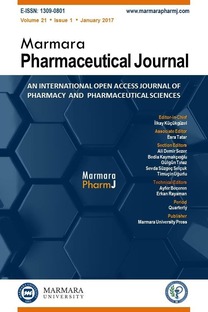Evaluation of avocado (Persea americanaMill.) leaves in terms of public health
___
[1]Sharma G, Sharma OC, Thakur BS. Systematics of Fruit Crops. New India Publishing Agency, New Delhi, 2009.[2]Yasir M, Das S, Kharya MD. The phytochemical and pharmacological profile of Persea americanaMill. Pharmacogn Rev. 2010; 4(7): 77-84.
[3]Demirkol A. Avocado growing in Turkey. Proceedings of the World Avocado Congress III. 1995: 451-456.
[4]Gruenwald J, Brendler T, Jaenicke C (Scientific Editors). Physicians Desk Reference (PDR) for Herbal Medicines. Thirth Edition, Thomson/Medical Economics Company, Montvale, New Jersey, 2004.
[5]Bayram S. BATEM, 2010 Yılı Avokado Gelişim Raporu, 2010.
[6]Sargin SA. Ethnobotanical survey of medicinal plants in Bozyazi district of Mersin, Turkey. J Ethnopharmacol. 2015; 173: 105-126.
[7]Josabad Alonso-Castro A, Jose Maldonado-Miranda J, Zarate-Martinez A, JacoboSalcedo MR, Fernández-Galicia C, Alejandro Figueroa-Zuñiga L, Abel Rios-Reyes N, Angel de León-Rubio M, Andrés Medellín-Castillo N, ReyesMunguia A, Méndez-Martínez R, Carranza-Alvarez C. Medicinal plants used in the Huasteca Potosina, México. J Ethnopharmacol. 2012; 143: 292-298.
[8]Clement YN, Baksh-Comeau YS, Seaforth CE. An ethnobotanical survey of medicinal plants in Trinidad. J Ethnobiol Ethnomed. 2015; 11: 67.
[9]Tene V, Malagón O, Finzi PV, Vidari G, Armijos C, Zaragoza T. An ethnobotanical survey of medicinal plants used in Loja and Zamora-Chinchipe, Ecuador. J Ethnopharmacol. 2007; 111: 63-81.
[10]Dike IP, Obembe OO, Adebiyi FE. Ethnobotanical survey for potential anti-malarial plants in south-western Nigeria.J Ethnopharmacol. 2012; 144(3): 618-626.
[11]De Almeida AP, Miranda MMFS, Simoni IC, Wigg MD, Lagrota MHC, Costa SS. Flavonol monoglycosides isolated from the antiviral fractions of Persea americana(Lauraceae) leaf infusion. Phytother Res. 1998; 12: 562-7.
[12]Ogunbinu AO, Ogunwandeb IA, Flaminid G, Cionid PL. Volatile compounds of Persea americanaMill from Nigeria. J Essent Oil Bear Pl. 2007; 10: 133-138.
[13]Larijani K, Rustaiyan A, Azar PA, Nematollahi F, Taban S. Composition of essential oil of leaves ofPersea americanacultivated in Iran. Chem Nat Compd.2010; 46: 489-490.
[14]Owolabi MA, Coker HAB, Jaja SI. Bioactivity of the phytoconstituents of the leaves of Persea americana. J MedPlantsRes. 2010; 4: 1130-1135.
[15]Niogret J, Epsky ND, Schnell EQ, Schnell RJ, Heath RR, Meerow AW, Kendra PE.Analysis of sesquiterpene distributions in the leaves, branches, and trunks of avocado (Persea amerianaMill.). Am J Plant Sci. 2013; 4: 922-931.
[16]Oelrichs PB, Ng JC, Seawright AA, Ward A, Schaffeler L, MacLeod JK. Isolation and identification of a compound from avocado (Persea americana) leaves which causes necrosis of the acinar epithelium of the lactating mammary gland and the myocardium. Nat Toxins.1995; 3: 344-349.
[17]Miranda MMFS, Almeida AP, Costa SS, Santos MGM, Lagrota MHC, Wigg MD. In vitroactivity of extracts of Persea americanaleaves on acyclovir-resistant and phosphonoacetic resistant herpes simplex virüs. Phytomedicine.1997; 4(4): 347-352.
[18]Gomez-Flores R, Arzate-Quintana C, Quintanilla-Licea R, Tamez-Guerra P, Tamez-Guerra R, Monreal-Cuevas E, Rodríguez-Padilla C.Antimicrobial activity of Persea americanaMill (Lauraceae) (Avocado) and Gymnosperma glutinosum(Spreng.) Less (Asteraceae) leaf extracts and active fractions against Mycobacterium tuberculosis. American-Eurasian Journal of Scientific Research(AEJSR).2008; 3(2): 188-194.
[19]Engel N, Oppermann C, Falodun A, Kragl U. Proliferative effects of five traditional Nigerian medicinal plant extracts on human breast and bone cancer cell lines. J Ethnopharmacol. 2011; 137: 1003-1010.
[20]Rosas-Pinón Y, Mejía A, Díaz-Ruiz G, Aguilar MS, Sánchez-Nieto S, RiveroCruz JF. Ethnobotanical survey and antibacterial activity of plants used in the Altiplane region of Mexico for the treatment of oral cavity infections. J Ethnopharmacol. 2012; 141: 860-865.
[21]Bonilla-Porras AR, Salazar-Ospina A, Jimenez-Del-Rio M, Pereañez-Jimenez A, Velez-Pardo C. Pro-apoptotic effect of Persea americanavar. Hass (avocado) on Jurkat lymphoblastic leukemia cells. Pharm Biol. 2014; 52: 458-465.
[22]Oboh G, Odubanjo VO, Bello F, Ademosun AO, Oyeleye SI, Nwanna EE, Ademiluyi AO. Aqueous extracts of avocado pear (Persea americanaMill.) leaves and seeds exhibit anti-cholinesterases and antioxidant activities in vitro. J Basic Clin Physiol Pharmacol. 2016; 27: 131-140.
[23]Uysal S, Zengin G, Aktumsek A, Karatas S. Chemical and biological approaches on nine fruit tree leaves collected from the Mediterranean region of Turkey. J Funct Foods.2016; 22: 518-532.
[24]Adeboye JO, Fajonyomi MO, Makinde JM, Taiwo OB. A preliminary study on the hypotensive activity of Persea americanaleaf extracts in anaesthetized normotensive rats. Fitoterapia. 1999; 70: 15-20.
[25]Adeyemi OO, Okpo SO, Ogunti OO. Analgesic and antiinflammatory effects of the aqueous extract of leaves of Persea americana Mill (Lauraceae). Fitoterapia. 2002; 73: 375-380.
[26]Ojewole JA, Amabeoku GJ. Anticonvulsant effect of Persea americanaMill (Lauraceae) (Avocado) leaf aqueous extract in mice. Phytother Res. 2006; 20: 696-700.
[27]Brai BIC, Odetola AA, Agomo PU. Hypoglycemic and hypocholesterolemic potential of Persea americanaleaf extracts. J Med Food. 2007; 10: 356-360.
[28]Kolawole OT, Kolawole SO, Ayankunle AA, Olaniran IO. Methanol leaf extract of Persea americanaprotects rats against cholesterol-induced hyperlipidemia. Br J Med Med Res.2012; 2(2): 235-242.
[29]Mahmoud AH, Samy MN, Wanas AS, Kamel MS. Pharmacognostical investigation of leaf and stem of Persea americana. Int J Pharmacogn Phytochem Res. 2016; 8(4): 690-700.
[30]EuropeanPharmacopoeia, 7th edition. Volume 1. Strasbourg: Council of Europe, 2010.
[31]Metcalfe CR, Chalk L. Anatomy of Dicotyledones. Vol. 2, Clarendon Press, Oxford, 1965.
[32]Çelebioğlu S, Baytop T. Bitkisel tozların tetkiki için yeni bir reaktif.Farmakognozi Enstitüsü Yayınları, No. 10. Farmakolog 19: 301, 1949.
- ISSN: 1309-0801
- Yayın Aralığı: Yılda 6 Sayı
- Başlangıç: 1985
- Yayıncı: Marmara Üniversitesi
Bambang KUSWANDI, Prawita SARI, Mochammad Amrun HIDAYAT
Evaluation of avocado (Persea americanaMill.) leaves in terms of public health
Gülsen KENDİR, Ayşegül KÖROĞLU
Quantum-chemical free energy calculation of vinpocetine molecule release from sodium alginate
Yulia POLKOVNIKOVA, Halahakoon Amila JEEWANTHA, Kseniya KORYANOVA
Evaluation of antimicrobial activity of five Vincetoxicum taxa growing in Turkey
SEVDA GÜZEL, Gamze KÖKDİL, Mahmut ÜLGER, Gönül ASLAN
Gökçen TELLİ, Banu Cahide TEL, Bülent GÜMÜŞEL, Kansu BÜYÜKAFSAR
PELİN TELKOPARAN AKILLILAR, Yusuf Bayram TUGLU, Naznoosh SHOMALI MOGHADDAM
Shokooh KARIMI, Seyed Jalal HOSSEINIMEHR, Hamid Reza MOHAMMADI, Ali Reza KHALATBARY, Fereshteh TALEBPOUR AMIRI
Simultaneous determination of selected flavonoids from different Cistusspecies by HPLC-PDA
PERİHAN GÜRBÜZ, Müberra KOŞAR, Zühal GÜVENALP, KURUÜZÜM Ayşe UZ, Lütfiye Ömür DEMİREZER
Kevser TABAN, Nuraniye ERUYGUR, Osman ÜSTÜN
Assessment of in vitrogenotoxicity effect of homosalate in cosmetics
